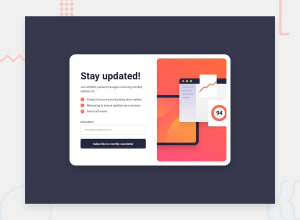
Newsletter signup using semantic html , css flexbox, js eventListeners
Design comparison
Solution retrospective
What I'm most proud of:
I'm most proud of the fact that I was able to create a fully functional newsletter sign-up form with a success message that meets the requirements of the Frontend Mentor challenge. I'm proud of the fact that I was able to write clean, readable, and maintainable code that is easy to understand and modify. I'm also proud of the fact that I was able to implement a responsive design that works well on different screen sizes
What I would do differently next time:
If I were to redo this project, there are a few things that I would do differently. Here are some of the key things that I would change:
Use a more robust email validation function: While my current email validation function works well for most cases, it's not foolproof. Next time, I would use a more robust email validation function, such as a regular expression, to ensure that the email address is valid. Add more error handling: While I do check if the email field is empty, I don't check for other potential errors, such as if the email address is already in use. Next time, I would add more error handling to make the form more robust. Use a more modular approach: While my code is relatively modular, there are some areas where it could be improved. Next time, I would break down the code into smaller, more manageable functions, each with its own specific task. Add more comments and documentation: While my code is relatively self-explanatory, it's always helpful to have comments and documentation to explain the functionality and design decisions. Next time, I would add more comments and documentation to make the code easier to understand and maintain. Use a CSS preprocessor: While my CSS code is relatively clean and organized, it could be improved with the use of a CSS preprocessor like Sass or Less. Next time, I would use a CSS preprocessor to make the CSS code more modular and efficient.
What challenges did you encounter, and how did you overcome them?Challenges encountered:
While working on this project, I encountered several challenges that required me to think creatively and come up with solutions. Here are some of the key challenges I faced:
Responsive design: One of the biggest challenges I faced was creating a responsive design that worked well on different screen sizes. I had to use media queries to adjust the layout and styling of the form and success message to ensure that they looked good on both desktop and mobile devices. Email validation: Another challenge I faced was creating a robust email validation function that could handle different types of email addresses. I had to research and experiment with different approaches before coming up with a solution that worked well. Success message animation: I also encountered a challenge when trying to animate the success message. I wanted to create a smooth transition between the form and the success message, but I had to experiment with different approaches before finding one that worked well. Cross-browser compatibility: Finally, I encountered a challenge when testing the form and success message in different browsers. I had to make sure that the form and success message looked and worked well in different browsers, which required some tweaking and debugging. How I overcame them:
To overcome these challenges, I used a combination of research, experimentation, and problem-solving skills. Here are some of the specific strategies I used:
Research and experimentation: When faced with a challenge, I would research different approaches and experiment with different solutions until I found one that worked well. Breaking down complex problems: When faced with a complex problem, I would break it down into smaller, more manageable parts, and focus on solving each part individually. Testing and debugging: I would test and debug my code regularly to ensure that it was working as expected, and make adjustments as needed. Seeking help when needed: Finally, I would seek help when needed, whether it was from online resources, documentation, or colleagues.
What specific areas of your project would you like help with?1.How can I make my email validation function more robust and foolproof?
2.What techniques or libraries can I use to improve the success message animation?
3.How can I make my responsive design more robust and flexible?
4.What best practices or techniques can I use to improve the organization and structure of my code?
5.How can I improve the accessibility of my project, and what specific steps can I take to make it more accessible to users with disabilities?
Community feedback
Please log in to post a comment
Log in with GitHubJoin our Discord community
Join thousands of Frontend Mentor community members taking the challenges, sharing resources, helping each other, and chatting about all things front-end!
Join our Discord
